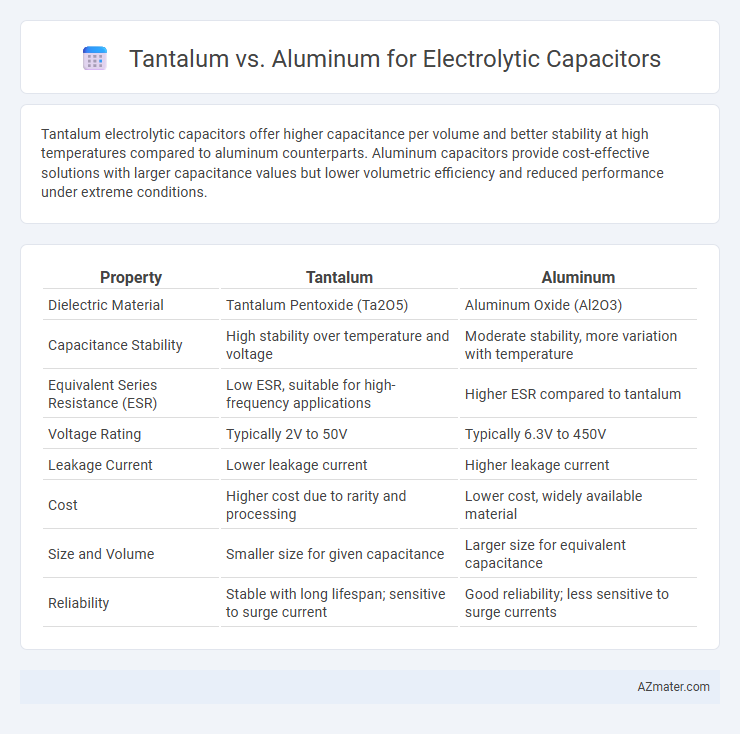Tantalum electrolytic capacitors offer higher capacitance per volume and better stability at high temperatures compared to aluminum counterparts. Aluminum capacitors provide cost-effective solutions with larger capacitance values but lower volumetric efficiency and reduced performance under extreme conditions.
Table of Comparison
| Property | Tantalum | Aluminum |
|---|---|---|
| Dielectric Material | Tantalum Pentoxide (Ta2O5) | Aluminum Oxide (Al2O3) |
| Capacitance Stability | High stability over temperature and voltage | Moderate stability, more variation with temperature |
| Equivalent Series Resistance (ESR) | Low ESR, suitable for high-frequency applications | Higher ESR compared to tantalum |
| Voltage Rating | Typically 2V to 50V | Typically 6.3V to 450V |
| Leakage Current | Lower leakage current | Higher leakage current |
| Cost | Higher cost due to rarity and processing | Lower cost, widely available material |
| Size and Volume | Smaller size for given capacitance | Larger size for equivalent capacitance |
| Reliability | Stable with long lifespan; sensitive to surge current | Good reliability; less sensitive to surge currents |
Introduction to Electrolytic Capacitors
Electrolytic capacitors utilize materials like tantalum and aluminum to achieve high capacitance in compact sizes, essential for filtering and energy storage in electronic circuits. Tantalum electrolytic capacitors offer superior volumetric efficiency and stability, making them ideal for applications requiring reliable performance at low voltage and temperature ranges. Aluminum electrolytic capacitors, while larger and less stable, provide cost-effective solutions with high capacitance values suitable for power supply filtering and decoupling.
Overview of Tantalum Capacitors
Tantalum capacitors offer higher capacitance per volume and superior stability compared to aluminum electrolytic capacitors, making them ideal for compact electronic devices requiring reliable performance. Their solid electrolyte and oxide layer provide low equivalent series resistance (ESR) and extended lifespan under high temperature conditions. Despite a higher cost, tantalum capacitors excel in applications demanding long-term reliability and stable capacitance values.
Overview of Aluminum Capacitors
Aluminum capacitors utilize an aluminum oxide layer as the dielectric, providing stable performance and high capacitance values at a low cost. They feature a liquid or solid electrolyte, which impacts their temperature tolerance, lifespan, and equivalent series resistance (ESR). These capacitors are widely used in power supply filtering and energy storage due to their robustness, large capacitance range, and cost-effectiveness compared to tantalum capacitors.
Capacitance and Voltage Ratings
Tantalum electrolytic capacitors offer higher capacitance values per volume compared to aluminum capacitors, making them ideal for compact applications requiring stable capacitance. Voltage ratings for tantalum capacitors typically range from 4V to 50V, whereas aluminum electrolytic capacitors can handle higher voltages, often exceeding 250V, suitable for high-voltage circuits. The dielectric properties of tantalum enable a more reliable and linear capacitance behavior under voltage stress, while aluminum capacitors provide broader voltage tolerance but with larger physical size.
Size and Form Factor Comparison
Tantalum electrolytic capacitors offer a smaller size and more compact form factor compared to aluminum electrolytic capacitors, enabling higher capacitance in limited space. The dense construction of tantalum allows for thinner profiles, making them ideal for miniaturized electronic devices where board space is critical. Aluminum capacitors typically require larger volume to achieve similar capacitance values, resulting in bulkier form factors unsuitable for modern compact designs.
Performance in High-Frequency Applications
Tantalum capacitors offer superior performance in high-frequency applications due to their lower Equivalent Series Resistance (ESR) and excellent stability under varying temperatures, resulting in reduced signal loss and enhanced reliability. Aluminum electrolytic capacitors typically exhibit higher ESR and inductance, which limits their efficiency and frequency response in RF and switching power supply circuits. Consequently, tantalum capacitors are preferred for high-frequency filtering and decoupling tasks where precise capacitance and minimal signal distortion are critical.
Reliability and Lifespan
Tantalum electrolytic capacitors exhibit superior reliability and longer lifespan compared to aluminum counterparts due to their stable oxide layer and high volumetric efficiency. They demonstrate excellent performance under high temperature and voltage stress, contributing to reduced failure rates in critical applications. Aluminum capacitors, though more cost-effective, generally have shorter operational lifespans and are susceptible to electrolyte drying, which can compromise long-term reliability.
Cost Analysis: Tantalum vs Aluminum
Tantalum electrolytic capacitors offer higher capacitance per volume and better stability but come at a significantly higher cost compared to aluminum capacitors, which are more economical and widely used in bulk applications. The raw material scarcity and complex manufacturing process drive up tantalum capacitor prices, while aluminum capacitors benefit from abundant aluminum supply and simpler production methods. Cost-efficiency analysis favors aluminum capacitors for budget-sensitive projects, whereas tantalum capacitors justify their premium in performance-critical or miniaturized designs.
Typical Applications and Use Cases
Tantalum electrolytic capacitors are commonly used in military and aerospace applications due to their high reliability, stability, and performance in extreme conditions, especially for power supply filtering and signal coupling. Aluminum electrolytic capacitors are favored in consumer electronics, such as power supplies and audio equipment, for their cost-effectiveness and high capacitance values at lower frequencies. Both types serve distinct roles based on operating voltage, size constraints, and environmental demands, with tantalum excelling in compact, high-reliability scenarios and aluminum preferred for bulk energy storage and general-purpose applications.
Choosing the Right Capacitor: Key Considerations
Tantalum capacitors offer high capacitance per volume, excellent frequency response, and stable performance, making them suitable for compact, high-reliability applications. Aluminum electrolytic capacitors provide higher capacitance values at a lower cost but have larger size and lower lifespan compared to tantalum types. Choosing between tantalum and aluminum capacitors depends on factors like voltage rating, ripple current tolerance, ESR requirements, and application-specific durability.

Infographic: Tantalum vs Aluminum for Electrolytic Capacitor
 azmater.com
azmater.com